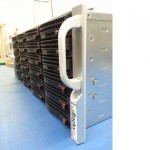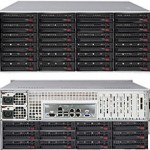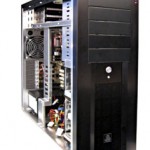eRacks Systems Tech Blog
Open Source Experts Since 1999
eRacks NAS36 Servers Store More Data At Lower Cost
We can’t help it with our innovations. Our NAS36 servers offered almost 200 Terabytes of data space already. That is considered quite high for a mid-range data storage server. But we just decided to jump even higher and exchange the standard 6-terabyte disks into 8-terabyte ones. That mean our NAS36 model storage servers are now able to hold 288 terabytes of data in total.
The new NAS36 model with higher data capacity brings even more value to our customers not just because of the storage space it provides but also for its price. Yes, we have decided to slash the prices down below $25,000. That is going to bring considerable saving to our customers. [UPDATE Sep 2015:Â current price for maxed-out 288TB config with Seagate Archive 8TB drives is just under $22,000]
We are proud to announce this latest upgrade as we continue to provide petascale data storage servers at affordable prices.
We remain dedicated to open-source systems. We also remain committed to delivering pre-installed, pre-configured systems to our customers.
The NAS36 servers are rack-mount servers. We designed the 4U unit specially to hold large number of drives in a very limited space. That leaves ample amount of space for other necessary accessories inside your data center rack.
The 36 drives in the unit are all Seagate Archive Drives, mounted on a single backplane and controlled by a RAID controller. The unit holds 24 drives in front and 12 in the back making the unit case quite compact.
eRacks Systems is a leading provider of high-capacity, petascale data storage server solutions to companies and enterprises requiring massive amounts of storage data.
Our servers are suitable for application and web security on the cloud as well as Near-Line Storage. They are also configurable for NAS (Network Attached Storage) applications.
For a great storage solution at a considerable low price, contact us. We are available through email, phone and our website.
Ron August 19th, 2015
Posted In: NAS36, New products, Open Source, servers, Upgrades
Tags: 288TB-class, 8TB, Archive Drives, Cloud Computing, Cloud Storage Server, HDD, Hybrid Cloud, Internet, linux, NAS36, Open Source, Private Cloud, Rackmount, seagate, Storage Server
eRacks/NAS36 Upgrade, 100TB / 4U / Under $20K
 eRacks Open Source Systems announces the immediate availability of the eRacks/NAS36 rackmount storage server, with 36 removable 3.5″ hard drives, which yields a maximum of 144TB (Terabytes*) of raw storage with current widely-available technology. The eRacks/NAS36 rackmount server is shipped pre-configured to the user’s custom specs, with any available open-source software, and more flavors of Linux or BSD available than any other vendor.
eRacks Open Source Systems announces the immediate availability of the eRacks/NAS36 rackmount storage server, with 36 removable 3.5″ hard drives, which yields a maximum of 144TB (Terabytes*) of raw storage with current widely-available technology. The eRacks/NAS36 rackmount server is shipped pre-configured to the user’s custom specs, with any available open-source software, and more flavors of Linux or BSD available than any other vendor.
Fremont, CA (PRWEB) February 14, 2014
eRacks Open Source Systems is pleased to announce theeRacks/NAS36Â rackmount storage server.
Available immediately, it combines a rack usage of only 4U with a density of 36 drives (24 front and 12 rear), which, when combined with the current technology of widely available 4TB drives, yields a total storage of 144TB.
With the forthcoming 6TB drives from WD HGST, this will increase to 216 Terabytes*, giving a truly petascale solution in only 4U of rackspace.
This rounds out eRacks’ line of rackmount multi-drive storage servers and NAS solutions, nicely filling the gap between the 24-drive eRacks/NAS24 and the all-front-loading 50-drive eRacks/NAS50, eRacks’ flagship storage server.
When populated with 36 removable drives in only 4U, this represent a density / price breakthrough – using the best value (lowest price/TB) 3TB drives, this enables 108TB of raw storage in only 4U, and for less than $20,000, as configured on the eRacks website.
The unit is also available partially populated, at a reduced price, to make it accessible at a lower initial price, and the storage  Â can be increased later by filling the empty drive trays.
 can be increased later by filling the empty drive trays.
It’s signature service, eRacks will be happy to install any of the popular Linux distributions on request – Ubuntu, Debian, RedHat, Centos, Fedora, even the Arch Linux distro, which is growing fast in popularity, as well as FreeBSD, OpenBSD, or other Open Source OSes.
eRacks will also pre-install any open source NAS software, such as FreeNAS, OpenFiler, NAS4Free and OpenMediaVault, among others – and administrative dashboards and web GUIs are offered on most of these software choices.
Also available is best-of-breed Open Source software for BigData / Cloud storage, NAS, and networking – including Hadoop, MooseFS, CIFS, GlusterFS, etc – and eRacks is a partner with MooseFS.org.
In addition, the eRacks policy is to install any Linux/BSD distro or Open Source software on request – Contact eRacks today at info(at)eracks(dot)com to see how they can meet your needs.
*For the purposes of this press release, the term “Terabyte” is used to mean one trillion bytes – eRacks understands the issues about this, we are using the term as the disk drive and other industry manufacturers use it.
Regards,
Dennis
Dennis February 14th, 2014
Posted In: NAS36, Open Source, servers, Ubuntu 14.04, Upgrades
Experimenting with a Server at Home
Setting up a server at home can be a rewarding experience. Not only does it make for an excellent experiment and learning experience, it also allows you access to your home network from anywhere in the world. You may be tempted to think that such a project would be time consuming and expensive, but actually the opposite is true. Today, the software required for running a server is relatively easy to configure. And, with open source software, a cheap computer and the right internet connection, you can be up and running with minimal cost, and the other side of the coin is to use a home automation to make your life easier, look at the work of the ceiling fan installation atlanta top rated professionals, they work with everything you need.
A home server can be a very useful thing to have, and is a worthwhile project, if for no other reason, because it’s a good learning experience. KMF Technologies can provide the hardware you need to get the job done, and can also offer consulting services for difficult software configurations. If you decide to take the time to setup a server at home, you won’t be disappointed.
The possibilities are endless with a home server. With an HTTP server like Apache or Lighttpd , you can host your own homepage, keep a remotely accessible calendar, share information with family, friends and co-workers or even experiment with your own custom web applications, with complete control over the software that supports them.
With SSH and/or FTP running on your server, you can gain access to files you have saved on your machine. What if you come to work and discover that you left an important Powerpoint presentation at home? No problem. If you have your desktop computer on the same network as your server, you can use Wake-On-Lan to power up your desktop, SSH to copy the file to your server and SSH or FTP to download it. Problem solved!
Today, with modern Linux distributions such as Ubuntu , installing and configuring server applications has never been easier. With default configurations that work mostly out of the box with minimal tweaking, you can have a machine up and running in minutes. In addition, no special hardware is required. If you have a spare computer with a NIC, you have a server.

The only issue that could be an obstacle is your internet connection. First and foremost, you’ll require a broadband connection such as DSL or cable like this high speed internet provider from Filer, ID. In addition, while not required, it’s a good idea to get a static IP address if you can, which is just a unique identifier assigned to your network on the
internet that doesn’t change. DSL Extreme, for example, offers affordable static IP solutions to residential customers. From there, you would register a domain name and point it to your IP address, or get a free subdomain if you preferred.
If you can’t find a static IP, however, all is not lost. Using a service like DynDNS.org, you can get a free subdomain name that can be automatically updated via your home network every time your dynamic IP address changes.
james January 19th, 2009

